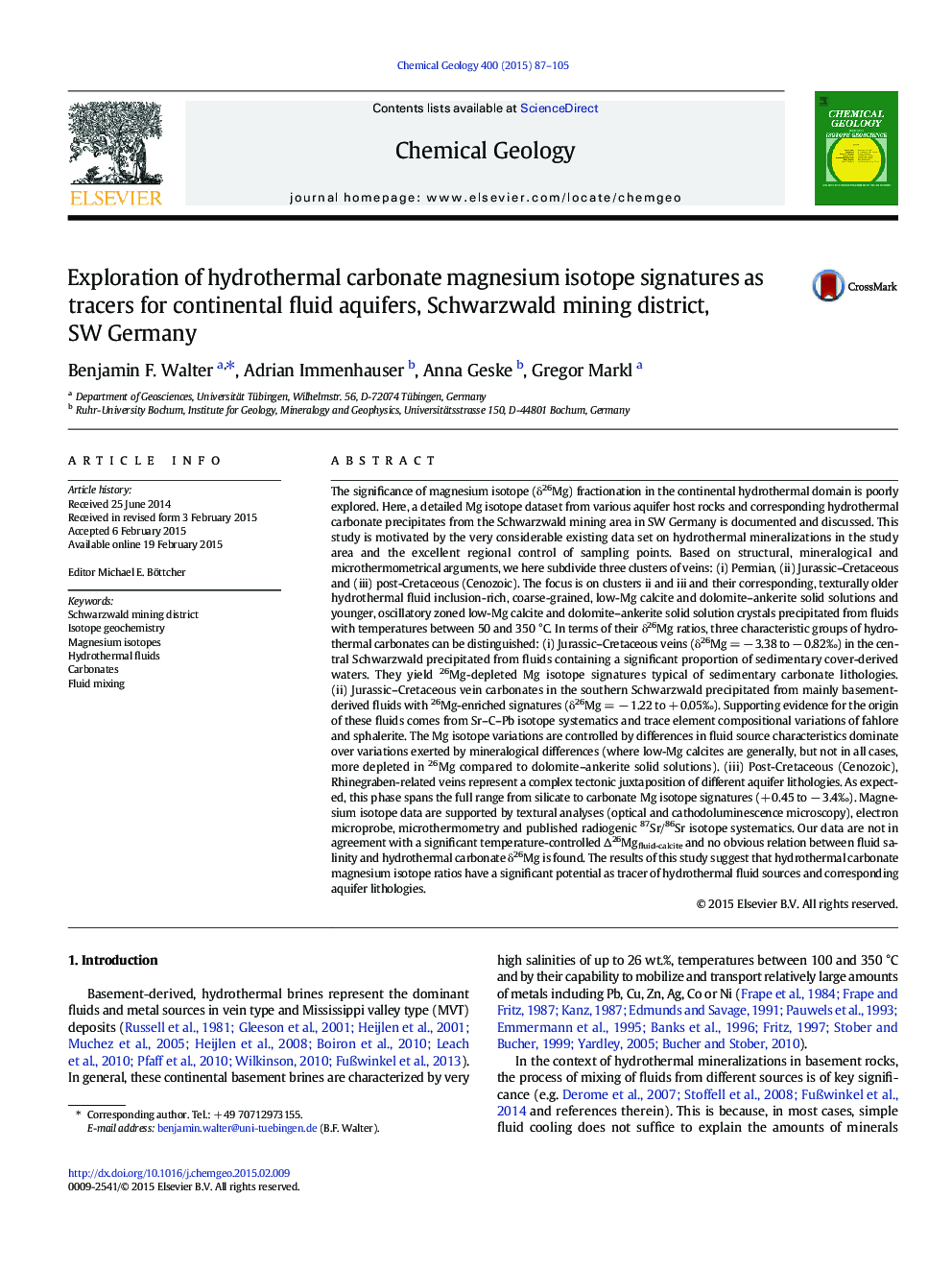| کد مقاله | کد نشریه | سال انتشار | مقاله انگلیسی | نسخه تمام متن |
|---|---|---|---|---|
| 4698566 | 1637573 | 2015 | 19 صفحه PDF | دانلود رایگان |

• First magnesium isotope data of hydrothermal continental carbonates in ore deposits
• Magnesium isotope systematics in context of microthermometrical data (salinity, temperature)
• Magnesium isotope systematics in context of different continental fluid aquifers
• Magnesium isotope systematics in combination with detailed textural classification of the samples
• Magnesium isotope data as source/aquifer tracer for hydrothermal fluids
The significance of magnesium isotope (δ26Mg) fractionation in the continental hydrothermal domain is poorly explored. Here, a detailed Mg isotope dataset from various aquifer host rocks and corresponding hydrothermal carbonate precipitates from the Schwarzwald mining area in SW Germany is documented and discussed. This study is motivated by the very considerable existing data set on hydrothermal mineralizations in the study area and the excellent regional control of sampling points. Based on structural, mineralogical and microthermometrical arguments, we here subdivide three clusters of veins: (i) Permian, (ii) Jurassic–Cretaceous and (iii) post-Cretaceous (Cenozoic). The focus is on clusters ii and iii and their corresponding, texturally older hydrothermal fluid inclusion-rich, coarse-grained, low-Mg calcite and dolomite–ankerite solid solutions and younger, oscillatory zoned low-Mg calcite and dolomite–ankerite solid solution crystals precipitated from fluids with temperatures between 50 and 350 °C. In terms of their δ26Mg ratios, three characteristic groups of hydrothermal carbonates can be distinguished: (i) Jurassic–Cretaceous veins (δ26Mg = − 3.38 to − 0.82‰) in the central Schwarzwald precipitated from fluids containing a significant proportion of sedimentary cover-derived waters. They yield 26Mg-depleted Mg isotope signatures typical of sedimentary carbonate lithologies. (ii) Jurassic–Cretaceous vein carbonates in the southern Schwarzwald precipitated from mainly basement-derived fluids with 26Mg-enriched signatures (δ26Mg = − 1.22 to + 0.05‰). Supporting evidence for the origin of these fluids comes from Sr–C–Pb isotope systematics and trace element compositional variations of fahlore and sphalerite. The Mg isotope variations are controlled by differences in fluid source characteristics dominate over variations exerted by mineralogical differences (where low-Mg calcites are generally, but not in all cases, more depleted in 26Mg compared to dolomite–ankerite solid solutions). (iii) Post-Cretaceous (Cenozoic), Rhinegraben-related veins represent a complex tectonic juxtaposition of different aquifer lithologies. As expected, this phase spans the full range from silicate to carbonate Mg isotope signatures (+ 0.45 to − 3.4‰). Magnesium isotope data are supported by textural analyses (optical and cathodoluminescence microscopy), electron microprobe, microthermometry and published radiogenic 87Sr/86Sr isotope systematics. Our data are not in agreement with a significant temperature-controlled Δ26Mgfluid-calcite and no obvious relation between fluid salinity and hydrothermal carbonate δ26Mg is found. The results of this study suggest that hydrothermal carbonate magnesium isotope ratios have a significant potential as tracer of hydrothermal fluid sources and corresponding aquifer lithologies.
Journal: Chemical Geology - Volume 400, 14 April 2015, Pages 87–105